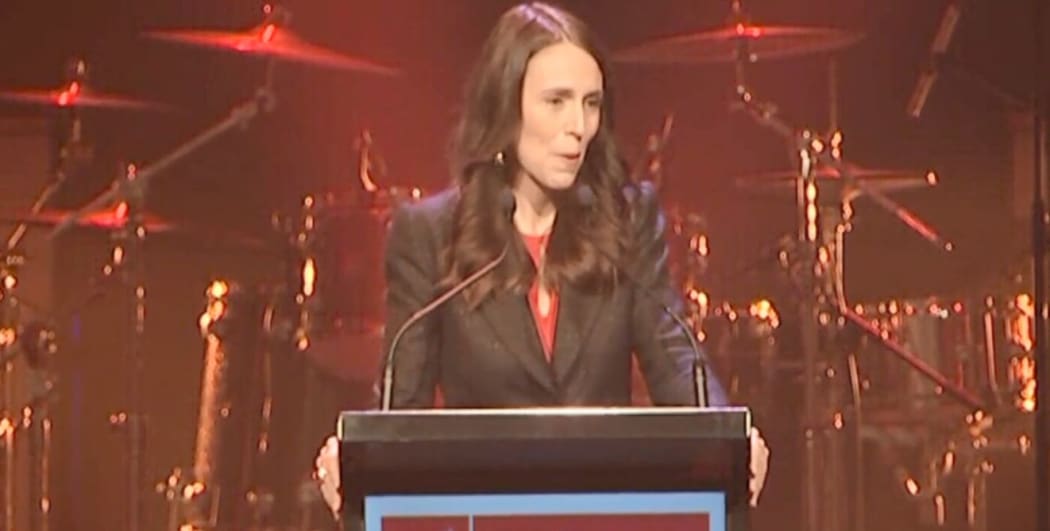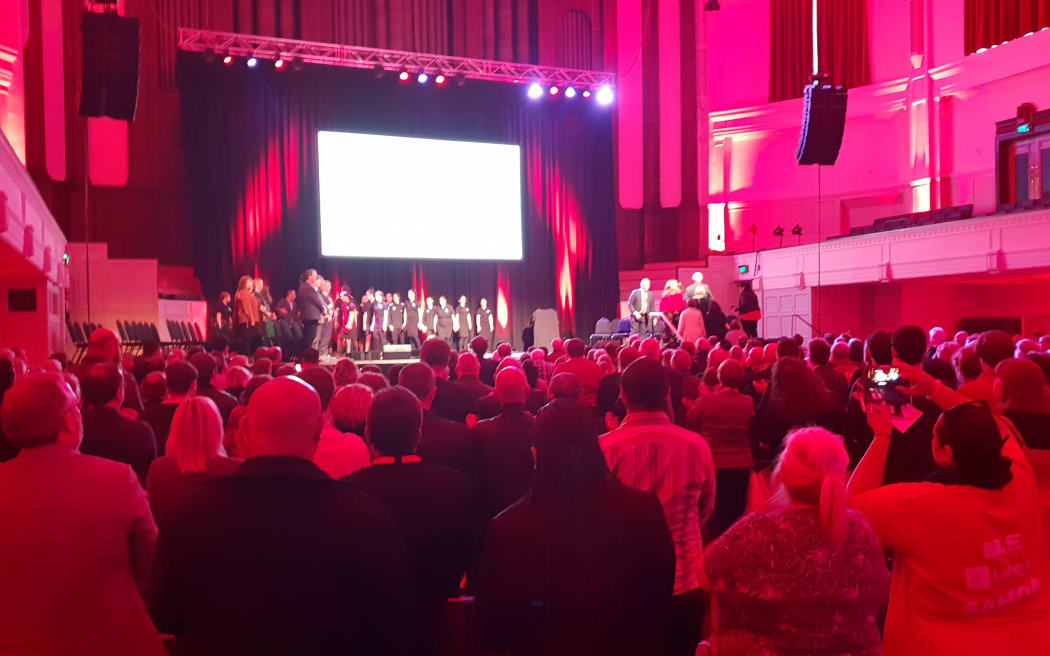Thirty years ago, deep divisions in the Labour Party were thrown in sharp relief by the media during its annual conference in Dunedin. But the media were much better managed when the party returned last weekend.

Photo: screenshot /rnz.co.nz
"In a tightly-scripted affair, Labour did its level best to appear unified and dignified," the Otago Daily Times' reporter Mike Houlahan wrote after the party's conference wrapped up on his patch last weekend.
"There were few signs of dissent, and everyone seemed to have received the memo that this conference was about looking business-like, rolling up your sleeves and getting down to work," he wrote.
The image of an apparently deeply-contented party come across strongly in the media. Pictures of people queuing down the block to see Jacinda Ardern speak reinforced that.
Everyone appearing in reports about the conference seemed on-message. In fact every delegate in the theatre was reminded of the message.
A placard with the official slogan “let’s keep doing this” was placed on each seat.
That was a variation on the theme of the “let’s do this” slogan the party picked in a hurry when they installed Jacinda Ardern as leader in mid-2017.
When the leader used it in her conference speech, it was pulled out as a key soundbite in the six o'clock TV news. With the warm-up band's drumkit as a backdrop, she looked every inch the rock-star PM.
When political reporters are reporting your party slogans and speeches - and not slip-ups - you know you’re winning.
Most reports after the conference began with Jacinda Ardern's announcement of 600 new special needs teachers. But policy wise, that was about it.
Most of the rest of the TV reports centred on the leader’s set piece speech, and her anecdotes and gags.
But party conferences are about much more than a handful of tub-thumping speeches, or single headline-making policies which could be announced at any time.
Our biggest political parties have thousands of members and delegates from all over the country met to discuss policy, strategy and direction.
But we heard almost nothing in the media about what the rank and file reckon or what the party machine is up to. .
Modern political 'media management' plays a bit part in this.
"It's to keep the fringe people out of the media spotlight," political PR professional David Cormack said on Newshub Nation last weekend ahead of Labour's conference,
"You keep the remits under wraps. New Zealand First chose not to and a big, old racist remit came out of their conference. National and Labour often keep their remits behind closed doors and some of the smaller parties might want to consider this as well," said David Cormack, who has worked for Labour and the Greens in the past.
The show's other panelists - Newshub's political editor and another political PR consultant - agreed keeping the media away from any discussion of party policy was “sensible political management”.
"It is hardly the behaviour of a party that claims to be part of the most open Government we have seen," said New Zealand Herald political editor Audrey Young.
RNZ Political editor Jane Patterson described it as a "locked down affair" for media .
"All of the policy discussions were behind closed doors, unlike at National's conference a few months back where journalists were free to sit in on most of the sessions and report," she wrote on rnz.co.nz.
However, that increased access didn't seem to make much difference to the reporting of National’s conference back in August.
Coverage of that conference overwhelmingly focused on leader Simon Bridges.
Just like last weekend’s Labour conference, the one big policy announcement was more teachers in schools but political reporters were distinctly underwhelmed by it. Newshub's Tova O Brien said he "pinched it" from a former Labour leader five years earlier.
Having said he wanted to win a contest of ideas, he lost a personality contest with Jacinda Ardern who prompted the media to pivot by releasing Facebook video featuring baby Neve from her couch at home.
The political PR people lined up as pundits praised that bit of 'media management' at the time too.
National's conference hosted discussions about education policy, the environment and welfare led by the party spokespeople.
But to get any details of them you had to visit the online startups selling their news online to subscribers.
On his website politik.co.nz, Richard Harman said National's policy rewrite is underway and "showing signs of swinging to the centre." He reported a session on rethinking foreign trade and defence policy - debates on water and climate change.
Farmers from Kaikōura, he reported, urged National to act now to cope with an unpredictable climate in future and climate change spokesperson Todd Muller talked about bipartisan policy with the Greens.
Newsroom Pro reported Judith Collins promising to reform planning and resource management, Nikki Kaye working on the quality of teachers and special needs schooling.
A session on reviving the party’s Roads of National Significance policy was led by transport spokesman at the time Jami-Lee Ross. How times change . . . .
But hardly any of these things were reported in mainstream news media at the time.

Prime Minister Jacinda Ardern received a standing ovation as she arrived at the party conference. Photo: RNZ / Jane Patterson
With the media shut out of policy discussions at Labour’s conference, does that mean there was nothing else to report on but the set piece speeches?
Not quite
On Politik.co.nz this time round, Richard Harman reported minister of finance Grant Robertson spoke about cornerstones of what will become known as the wellbeing budget next year.
New yardsticks were already being used for ministers' negotiating over funding in next year's Budget.
In an editorial on Tuesday, the Otago Daily Times noted these new measure of economic and social progress will need to be closely scrutinised.
Good point. But so far they’ve barely mentioned them in the media.
While the prime minister's partner, Clarke Gayford, grabbed media attention as warmup act for her speech, Richard Harman said one of the Government's most influential ministers, David Parker, was the MC for day one.
“I am convinced it is the insecurity of the middle class and the huge riches that have been amassed around the world to the one per cent,” he said in a speech about the threats of the protectionism of Trump and the nationalism of Brexit.
Richard Harman also reported that party members in closed sessions urged the Government to stick to a Labour agenda.
There were calls for subsidies on women’s sanitary products, free dental care and for the Commerce Commission to investigate the supermarket duopoly.
None of that was reported elsewhere in the media either.
Local members even elected to change the constitution to allow for a rural representative to go on to the ruling Council, Politik.co.nz reported
That's an interesting move in the week some outlets picked up a story about MP’s lacking rural experience these days - a story that came from yet another PR consultant:
Many of the preview pieces about the Labour conference pointed out that until last year's election the party was out of power, low on optimism and low on cash.
Things have changed under new leadership - that's in power.
Newsroom’s Sam Sachedeva interviewed the party's president Nigel Haworth who said the party had signed off on its plans for the next two years, with a campaign group already up and running potential candidates for 2020 was already being considered.
He also described the party’s financial position as “essentially the best it’s been in for a very very long time, possibly ever”.
How come? And where the new money had come from would be a big issue given recent ruckus over donations to the opposition, you’d think, but there was little about those issues elsewhere in the media.
"No doubting the mood at Labour. The scarves and hats were brightest of reds, the smiles wide and the cheese rolls abundant," wrote Audrey Young.
There was plenty more such scene-setting of the Labour conference in the media - but little of what went on behind those scenes. The party members were mainly wallpaper.

